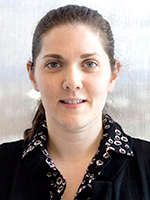
Primary care physician shortages in BC linked to smaller practice sizes and fewer patient visits per physician.
It is no secret that many Canadians have a hard time finding a family doctor or are on long waitlists to see a paediatrician, obstetrician or gynaecologist. This comes despite the fact that the number of primary care physicians in Canada has been on the rise since 1986—a conundrum that is addressed in a new study led by Vancouver Coastal Health Research Institute researcher, Lindsay Hedden.
Hedden began her investigation after reading an editorial out of the United Kingdom that implied that physician shortages were caused by a rise in female primary care workers. This paper made her want to explore whether there was any evidence for this in a Canadian context.

“I went in trying to understand why Canada is experiencing shortages despite having more physicians per capita than ever before,” says Hedden. “One explanation we explored is whether shifts in the demographic of the physician workforce, such as aging and feminization, could be contributing. If there is a preponderance of women or older doctors that are engaged in part-time work arrangements, even though we have more physicians, ultimately we would have less service delivery.”
In their report “In British Columbia, the supply of primary care physicians grew, but their rate of clinical activity declined,” Hedden and co-authors tease apart the effects of feminization and aging on trends in the primary care physician workforce.
Counter to the original editorial, their findings—published in the journal Health Affairs in December 2017—reveal that both aging and feminization of the workforce have had a mild impact on the availability of primary care. Instead, they found that the main driver of the physician shortages occurring in British Columbia is a decrease in activity levels over time across all physician demographic groups.
“Simply put, physicians in all demographic groups and across rural and urban areas are seeing fewer patients and reducing their practice sizes.”
“Physicians are shrinking their practice sizes over time, and they have fewer patient visits overall.”
Another finding revealed in the paper is that physician remuneration has remained on par with increases in cost of living since the mid-1980s, despite the decrease in physician activity levels. This, Hedden says, has to do with the incentive payments given to physicians who see patients with multiple chronic diseases or disorders. The payments are designed to encourage physicians to spend more time with this patient population; however, Hedden argues that this could also lead to physicians seeing fewer patients, which has the effect of limiting access to care.
Part-time model popular among primary care physicians
Since the 1960s, BC and Canada have seen a significant increase in the number of women in medical school and practicing medicine, particularly in primary health care.
“Primary care has experienced the highest increase in female practitioners across all of the physician specialties.”

Older physicians are also more likely to be involved in part-time work arrangements and restrict their practices to see certain types of patients and do certain types of activities. With the baby boomer generation set to retire soon, this could also lead to shortages in primary care physicians.
Add to this the fact that our population as a whole is aging—in 2016, there were more seniors in Canada than children for the first time—yet another trend that is contributing to a growing demand for primary health care physicians, particularly around access to chronic disease treatment.
The findings of Hedden and her colleagues put the numbers into perspective, crystallizing the broader impact these trends are having on the workforce.
“We found that the primary driver of physician shortages is a broad trend towards reduced clinical activity across all physician age and sex groups, and in both rural and urban areas.”
Over the course of their study period—which spanned from 2005-2012—Hedden and co-authors found that physician activity levels and practice sizes declined by 14 per cent and 10 per cent respectively.
Two hypotheses for this, Hedden says, is 1) that more physicians are prizing work-life balance over long hours and higher pay, and 2) physicians are spending more time with each patient or more time on administrative work because care is becoming more complex. If this trend continues, she says, there will be a loss of per-physician activity above and beyond current projections.
As a result, Hedden sees this paper as a call to policymakers to take a closer look at volume-driven payments for physicians and explore whether alternative remuneration and practice models would better serve both patients and physicians. In addition, she says, health service planners need to look at trends and activity over time—as opposed to static headcounts—when making supply projections.
“This will equip them with essential statistical information to help them determine how many physicians are needed and the geographic locations where they are needed.”


